High and Low Temperature Gold Mineralizations in the Fe–Cu–Zn Sulfide Deposits of Corchia Ophiolite, Northern Italian Apennine
Abstract
:1. Introduction
2. Geological Background of the Northern Apennine Ophiolite and the Associated Sulfide Deposits
3. The Corchia Ophiolite and Description of the Associated Deposits
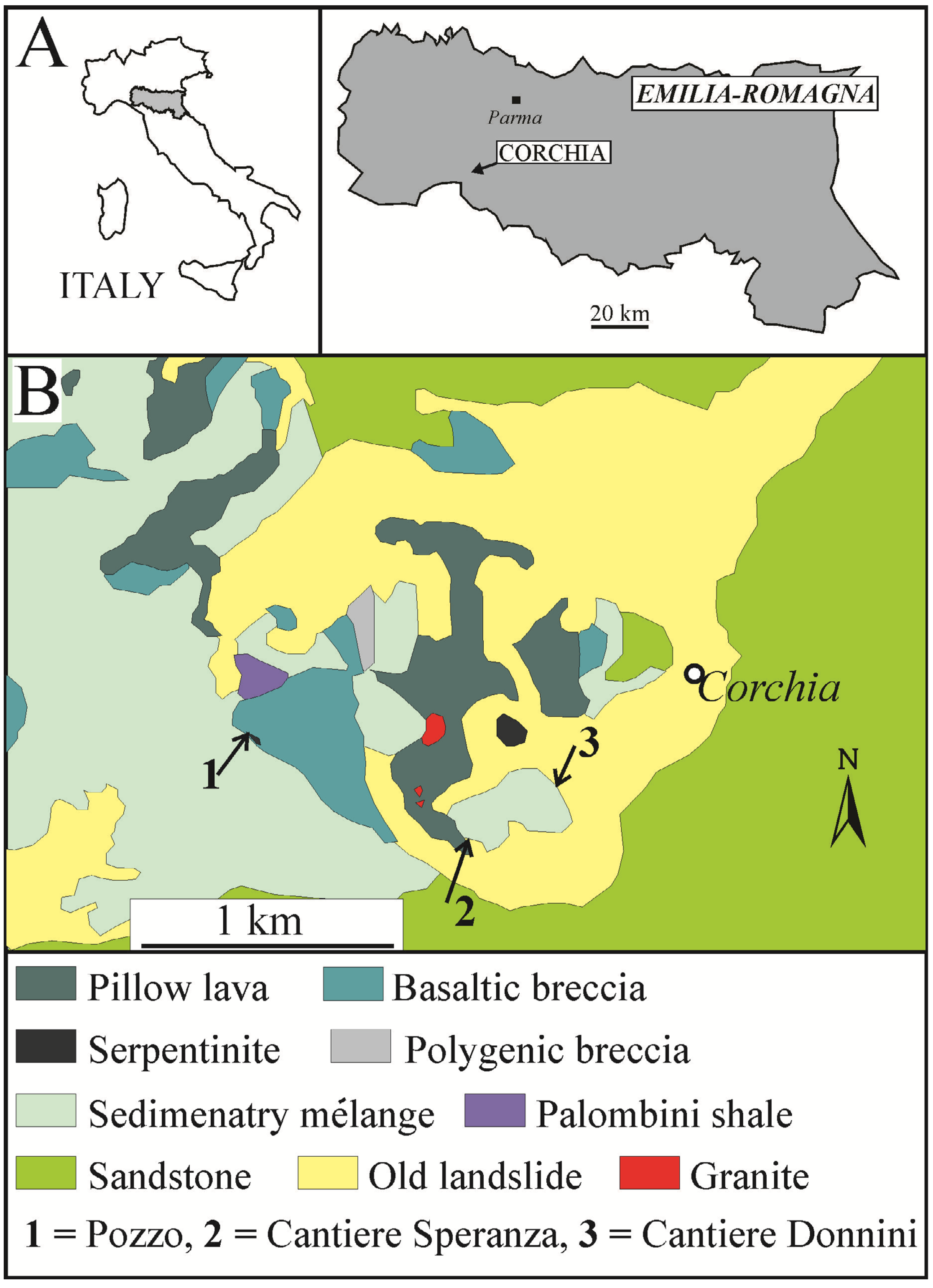
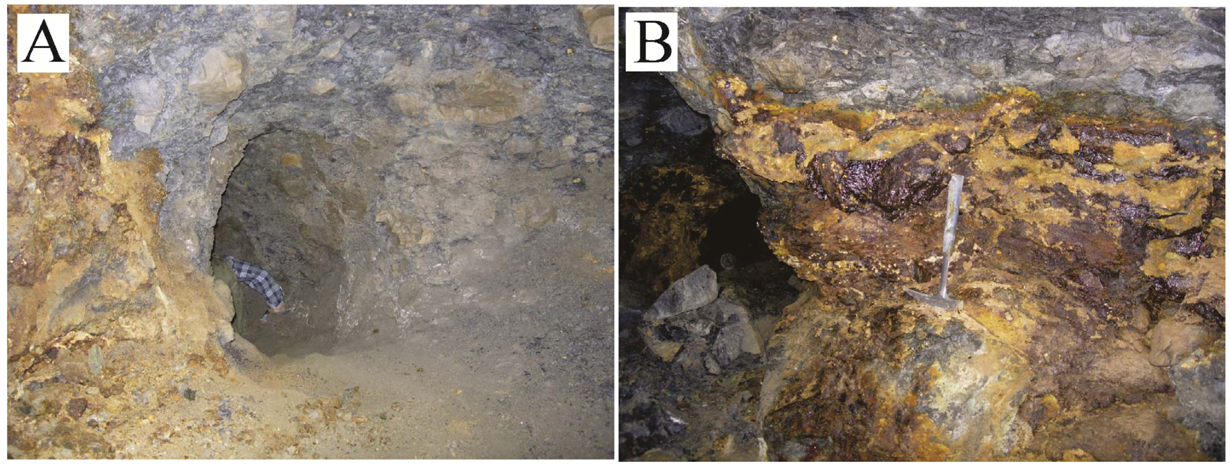
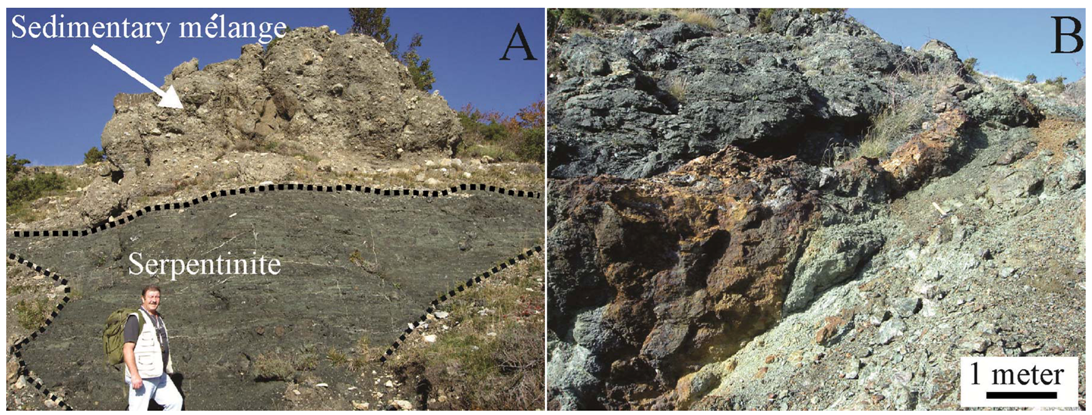
| Cantiere Donnini and Speranza | Pozzo | |
|---|---|---|
| Geology | Contact pillow-sedimentary rocks | Serpentinite |
| Ore minerals | Pyrite, chalcopyrite, sphalerite, magnetite | Chalcopyrite, pyrite, magnetite, sagenite, molybdenite |
| Textures | Massive, detrital, biogenic | Massive |
| Average δ34S‰ | 2.4 | 0.8 |
| Major gangue minerals | Quartz, chlorite, carbonates, clay minerals | Serpentine, chlorite |
4. Methodology
| Sample | Au | Os | Ir | Ru | Rh | Pt | Pd |
|---|---|---|---|---|---|---|---|
| COPO 1B | 2171 | 4 | 5 | 8 | 0 | 7 | 8 |
| COPO 2B | 1569 | 6 | 6 | 9 | 3 | 13 | 11 |
| COPO 3B | 6295 | 3 | 3 | 8 | 0 | 8 | 10 |
| CO 23 | 989 | 0 | 2 | 6 | 2 | 20 | 13 |
| wt% | Au | Ag | Fe | Ni | Cu | S | Total |
| copo1b 1 | 88.69 | 12.13 | 0.38 | 0 | 0.04 | 0.07 | 101.31 |
| copo1b 1 | 87.15 | 11.8 | 0.95 | 0 | 0.9 | 0.55 | 101.33 |
| copo1b 1 | 88.29 | 11.68 | 0.29 | 0.03 | 0.26 | 0.47 | 101.01 |
| copo1b 1 | 86.16 | 11.53 | 1.26 | 0 | 0.51 | 0.05 | 99.5 |
| copo1b 1 | 85.67 | 11.51 | 0.98 | 0 | 0 | 0.79 | 98.96 |
| copo1b 1 | 86.47 | 12.04 | 0.87 | 0.02 | 0.04 | 0.13 | 99.56 |
| copo1b 3 | 86.49 | 11.43 | 0.7 | 0 | 0.51 | 0.08 | 99.21 |
| copo1b 3 | 88.05 | 11.64 | 0.34 | 0.01 | 0.29 | 0.39 | 100.72 |
| copo1b 3 | 86.2 | 11.59 | 0.5 | 0 | 0.14 | 0.75 | 99.18 |
| copo1b 3 | 85.23 | 11.96 | 0.96 | 0 | 1.22 | 0.14 | 99.52 |
| copo1b 5 | 87.31 | 11.51 | 0.3 | 0.02 | 0.84 | 0.24 | 100.22 |
| copo1b 5 | 87.31 | 11.61 | 0.88 | 0 | 0.56 | 0.14 | 100.51 |
| copo1b 5 | 86.62 | 11.73 | 0.53 | 0.31 | 0.78 | 0.06 | 100.02 |
| copo1b 5 | 86.94 | 11.52 | 0.71 | 0 | 0.34 | 0.15 | 99.65 |
| copo2b 1 | 87.45 | 11.55 | 1.57 | n.a. | 1.12 | n.a. | 101.69 |
| copo2a 2 | 86.59 | 11.56 | 0.36 | n.a. | 0.37 | n.a. | 98.88 |
| copo2a 2 | 87.43 | 10.83 | 0.74 | n.a. | 0.64 | n.a. | 99.65 |
| copo2a 2 | 87.47 | 11.37 | 0.43 | n.a. | 0.59 | n.a. | 99.86 |
| copo2a 2 | 85.51 | 9.81 | 1.23 | n.a. | 1.74 | n.a. | 98.28 |
| copo2b 2 | 83.19 | 12.22 | 2.25 | n.a. | 2.51 | n.a. | 100.17 |
| copo2b 3 | 85.33 | 13.21 | 1.23 | n.a. | 2.05 | n.a. | 101.83 |
| copo2b 3a | 84.02 | 11.97 | 1.53 | n.a. | 2.45 | n.a. | 99.97 |
| copo2b 4 | 84.17 | 12.69 | 1.18 | n.a. | 1.90 | n.a. | 99.94 |
| copo2b 4 | 83.45 | 12.75 | 1.32 | n.a. | 1.90 | n.a. | 99.42 |
| copo2b 5 | 85.23 | 12.29 | 1.37 | n.a. | 1.63 | n.a. | 100.51 |
| copo2b 5 | 84.89 | 11.52 | 1.67 | n.a. | 2.70 | n.a. | 100.78 |
| copo2b 5 | 84.44 | 12.28 | 1.31 | n.a. | 1.95 | n.a. | 99.98 |
| copo2b 6 | 83.86 | 11.92 | 1.02 | n.a. | 2.07 | n.a. | 98.87 |
| copo3b 1 | 87.80 | 9.48 | 1.23 | n.a. | 0.33 | n.a. | 98.84 |
| copo3b 1 | 87.83 | 10.18 | 1.12 | n.a. | 0.24 | n.a. | 99.37 |
| copo3b 1 | 89.59 | 9.94 | 1.48 | n.a. | 0.13 | n.a. | 101.15 |
| copo3b 1 | 89.97 | 9.96 | 1.35 | n.a. | 0.31 | n.a. | 101.59 |
| copo3b 2a | 85.77 | 9.32 | 2.52 | n.a. | 2.86 | n.a. | 100.48 |
| copo3b 2a | 87.53 | 9.89 | 2.53 | n.a. | 2.94 | n.a. | 102.90 |
| copo3b 2c | 89.37 | 8.26 | 1.33 | n.a. | 2.16 | n.a. | 101.13 |
| copo3b 3 | 86.15 | 9.99 | 1.49 | n.a. | 2.49 | n.a. | 100.12 |
| copo3b 4b | 88.04 | 9.71 | 0.78 | n.a. | 1.15 | n.a. | 99.68 |
| at % | Au | Ag | Fe | Ni | Cu | S | |
| copo1b 1 | 78.67 | 19.65 | 1.19 | 0.00 | 0.11 | 0.38 | |
| copo1b 1 | 73.72 | 18.23 | 2.83 | 0.00 | 2.36 | 2.86 | |
| copo1b 1 | 77.15 | 18.64 | 0.89 | 0.09 | 0.70 | 2.52 | |
| copo1b 1 | 75.88 | 18.54 | 3.91 | 0.00 | 1.39 | 0.27 | |
| copo1b 1 | 74.50 | 18.28 | 3.01 | 0.00 | 0.00 | 4.22 | |
| copo1b 1 | 76.85 | 19.54 | 2.73 | 0.06 | 0.11 | 0.71 | |
| copo1b 3 | 77.29 | 18.65 | 2.21 | 0.00 | 1.41 | 0.44 | |
| copo1b 3 | 77.35 | 18.67 | 1.05 | 0.03 | 0.79 | 2.10 | |
| copo1b 3 | 75.50 | 18.54 | 1.54 | 0.00 | 0.38 | 4.04 | |
| copo1b 3 | 74.05 | 18.97 | 2.94 | 0.00 | 3.29 | 0.75 | |
| copo1b 5 | 76.90 | 18.51 | 0.93 | 0.06 | 2.29 | 1.30 | |
| copo1b 5 | 76.45 | 18.56 | 2.72 | 0.00 | 1.52 | 0.75 | |
| copo1b 5 | 76.16 | 18.83 | 1.64 | 0.91 | 2.13 | 0.32 | |
| copo1b 5 | 77.31 | 18.71 | 2.23 | 0.00 | 0.94 | 0.82 | |
| copo2b 1 | 74.38 | 17.94 | 4.71 | n.a | 2.96 | n.a | |
| copo2a 2 | 78.65 | 19.17 | 1.15 | n.a | 1.04 | n.a | |
| copo2a 2 | 78.19 | 17.69 | 2.33 | n.a | 1.79 | n.a | |
| copo2a 2 | 78.39 | 18.61 | 1.37 | n.a | 1.63 | n.a | |
| copo2a 2 | 75.59 | 15.83 | 3.82 | n.a | 4.76 | n.a | |
| copo2b 2 | 68.63 | 18.40 | 6.55 | n.a | 6.42 | n.a | |
| copo2b 3 | 71.01 | 20.08 | 3.62 | n.a | 5.29 | n.a | |
| copo2b 3a | 70.68 | 18.39 | 4.54 | n.a | 6.39 | n.a | |
| copo2b 4 | 71.69 | 19.74 | 3.55 | n.a | 5.02 | n.a | |
| copo2b 4 | 71.16 | 19.85 | 3.97 | n.a | 5.01 | n.a | |
| copo2b 5 | 72.51 | 19.09 | 4.11 | n.a | 4.30 | n.a | |
| copo2b 5 | 70.63 | 17.50 | 4.91 | n.a | 6.96 | n.a | |
| copo2b 5 | 71.84 | 19.08 | 3.94 | n.a | 5.15 | n.a | |
| copo2b 6 | 72.53 | 18.82 | 3.10 | n.a | 5.55 | n.a | |
| copo3b 1 | 79.49 | 15.67 | 3.91 | n.a | 0.92 | n.a | |
| copo3b 1 | 79.05 | 16.74 | 3.54 | n.a | 0.68 | n.a | |
| copo3b 1 | 79.02 | 16.01 | 4.61 | n.a | 0.37 | n.a | |
| copo3b 1 | 79.00 | 15.97 | 4.18 | n.a | 0.85 | n.a | |
| copo3b 2a | 71.15 | 14.12 | 7.37 | n.a | 7.36 | n.a | |
| copo3b 2a | 70.80 | 14.60 | 7.22 | n.a | 7.38 | n.a | |
| copo3b 2c | 77.14 | 13.02 | 4.05 | n.a | 5.79 | n.a | |
| copo3b 3 | 73.42 | 15.55 | 4.47 | n.a | 6.57 | n.a | |
| copo3b 4b | 78.54 | 15.81 | 2.46 | n.a | 3.19 | n.a |
5. Results
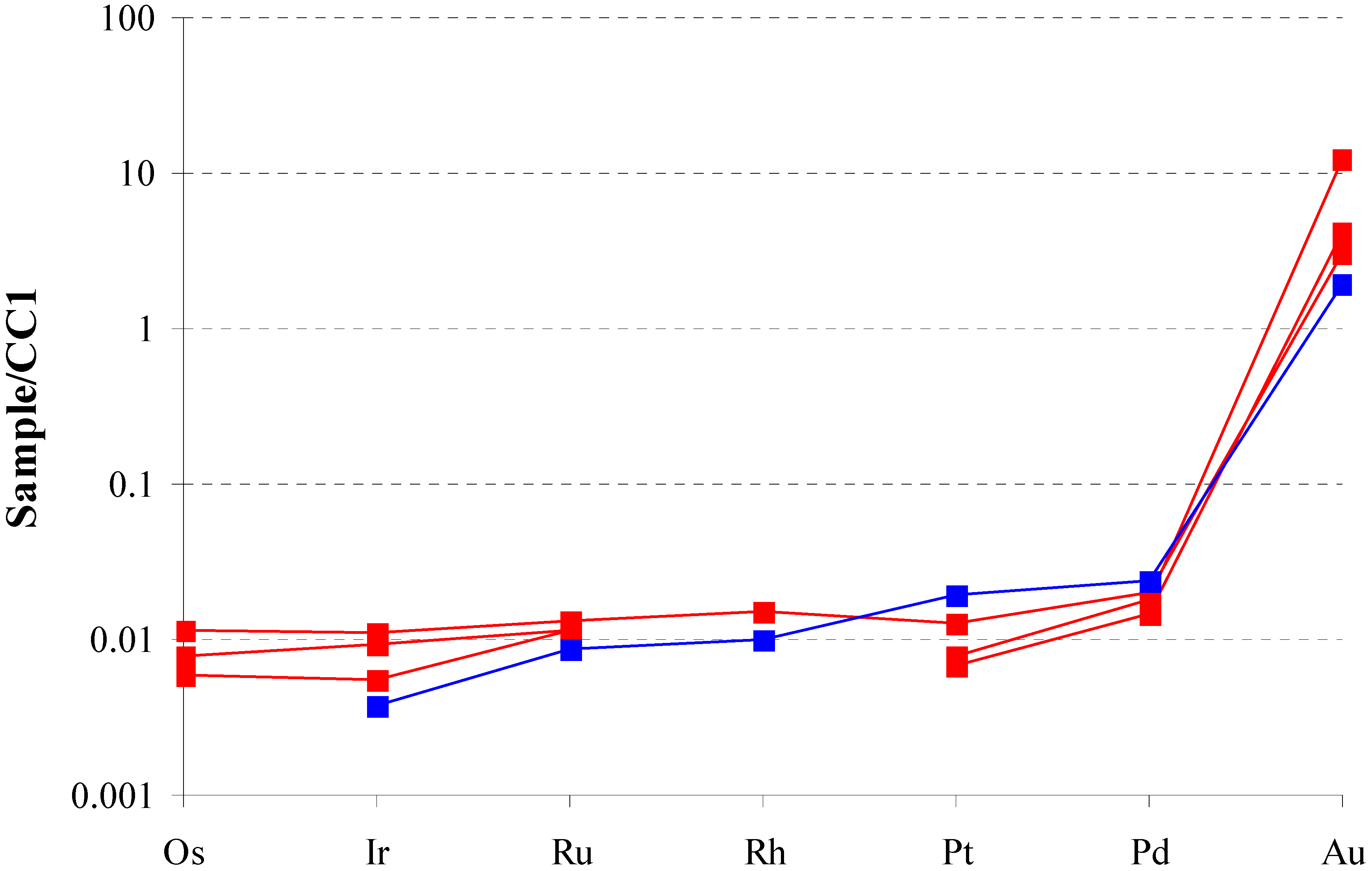
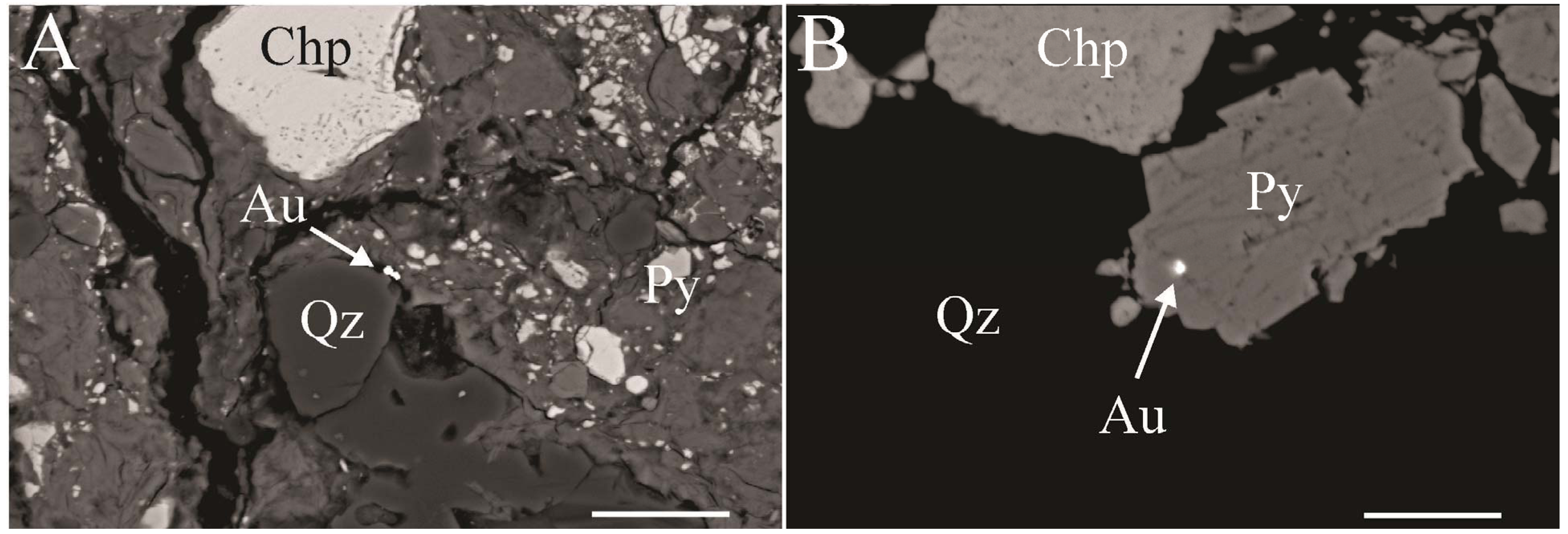
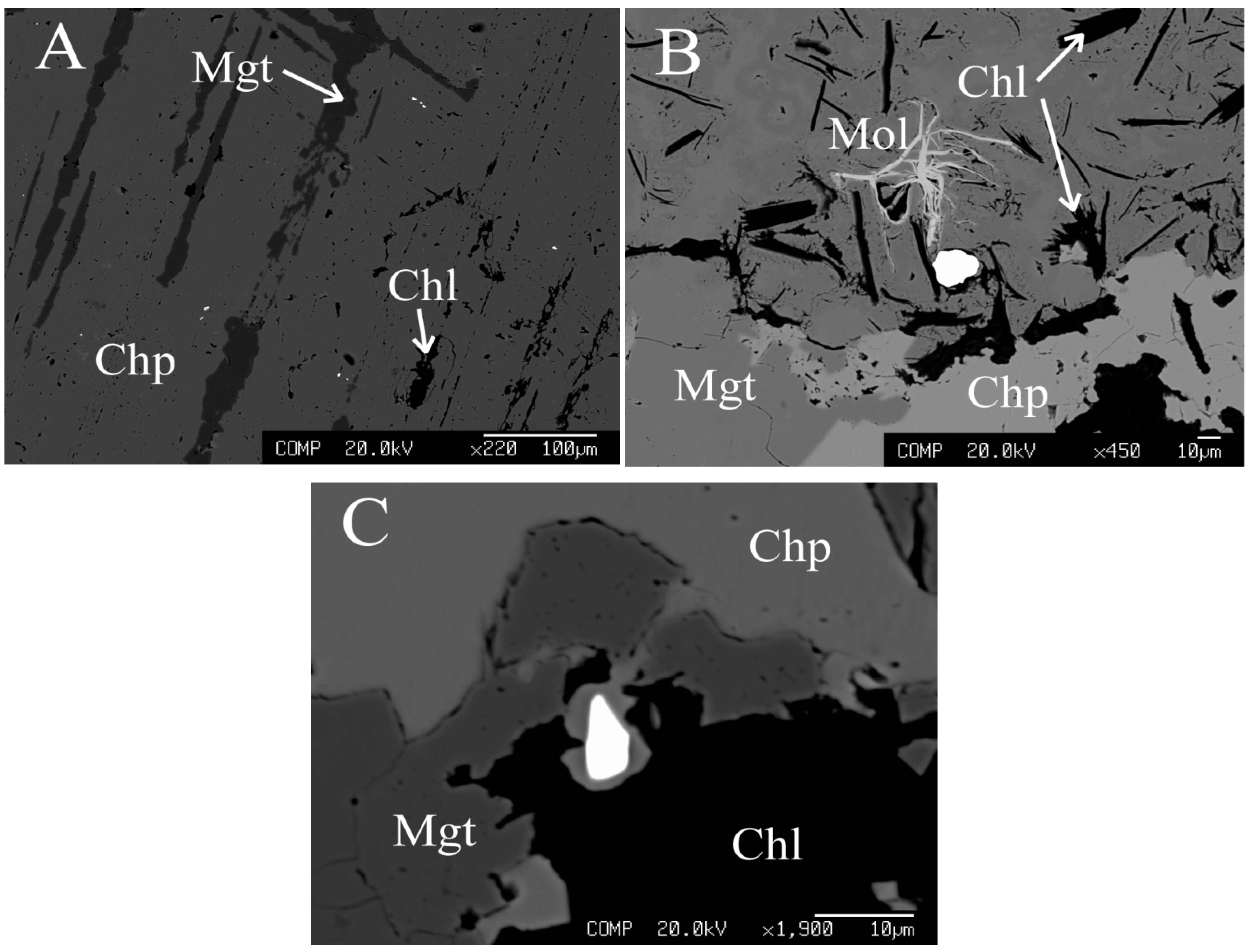
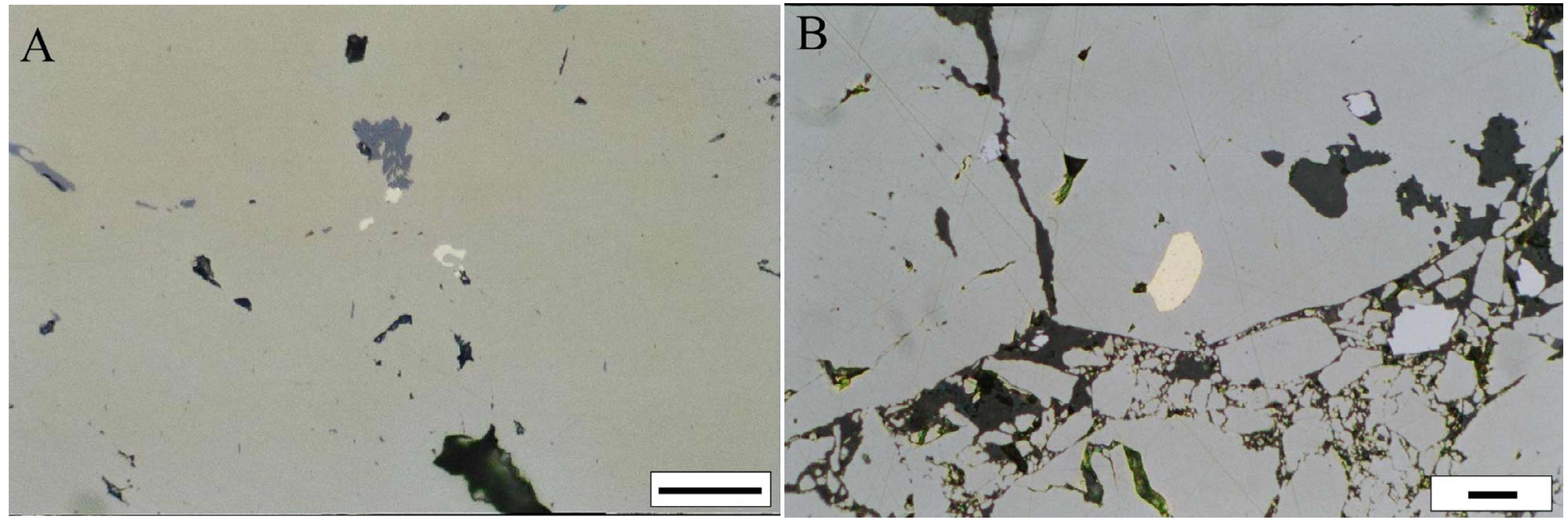

6. Concluding Remarks
Acknowledgments
References
- Garuti, G.; Zaccarini, F. Minerals of Au, Ag, and U in volcanic-rock-associated massive sulfide deposits of the northern Apennine ophiolite, Italy. Can. Mineral. 2005, 43, 935–950. [Google Scholar] [CrossRef]
- Zaccarini, F.; Garuti, G. Mineralogy and chemical composition of VMS deposits of the northern Apennine ophiolites, Italy: Evidence for the influence of country rock type on ore composition. Mineral. Petrol. 2008, 94, 61–83. [Google Scholar] [CrossRef]
- Maggi, R.; Pearce, M. Mid fourth-millenium copper mining in Liguria north-west Italy: The earliest known copper mines in western Europe. Antiquity 2005, 79, 66–77. [Google Scholar]
- Garuti, G.; Adorni, F.; Calderini, V.; Zaccarini, F. L’oro del “Pozzo”: Secondo ritrovamento di Oro nativo nell’ofiolite di Corchia, Berceto (Appennino Parmense). Micro 2008, 2, 133–144. [Google Scholar]
- Piccardo, G.B. The Jurassic Ligurian Tethys, a fossil ultraslow spreading ocean: The mantle perspective. Geol. Soc. Lond. 2008, 293, 11–34. [Google Scholar] [CrossRef]
- Garuti, G.; Bartoli, O.; Scacchetti, M.; Zaccarini, F. Geological setting and structural styles of volcanic massive sulfide deposits in the northern Apennines (Italy): Evidence for seafloor and sub-seafloor hydrothermal activity in unconventional ophiolites of the Mesozoic Tethys. Bol. Soc. Geol. Mex. 2008, 60, 121–145. [Google Scholar]
- Garuti, G.; Alfonso, P.; Zaccarini, F.; Proenza, J.A. Sulfur-isotope variations in sulfide minerals from massive sulfide deposits of the northern Apennine ophiolites: Inorganic and biogenic constraints. Ofioliti 2009, 34, 43–62. [Google Scholar]
- Vescovi, P.; Andreozzi, M.; de Nardo, M.T.; Lasagna, S.; Martelli, L.; Rio, D.; Tellini, C.; Vernia, L. Note illustrative della carta geologica d’Italia alla scala 1:50,000, foglio 216, Borgo Val di Taro. In Presidenza del Consiglio dei Ministri, Servizio Geologico d’Italia, Regione Emilia-Romagna; S.El.Ca. SRLS.El.Ca. SRL: Florence, Italy, 2002. [Google Scholar]
- Adorni, F.; Guelfi, F. La miniera di Fe e Cu di Corchia, Berceto (Appennino Parmense). Riv. Mineral. Ital. 1997, 3, 217–250. [Google Scholar]
- Stuppini, M. Le miniere di Corchia nel parmense. Spel. Emiliana 1998, 9, 13–25. [Google Scholar]
- Zaccarini, F.; Garuti, G.; Proenza, J.A.; Campos, L.; Thalhammer, O.A.R.; Aiglsperger, T.; Lewis, J. Chromite and platinum-group-elements mineralization in the Santa Elena ophiolitic ultramafic nappe (Costa Rica): Geodynamic implications. Geol. Acta 2011, 9, 407–423. [Google Scholar]
- Naldrett, A.J.; Duke, J.M. Platinum metals in magmatic sulfide ores. Science 1980, 208, 1417–1424. [Google Scholar]
- Groen, J.C.; Graig, J.R.; Rimstidt, J.D. Gold-rich rim formation on electrum grains in placers. Can. Mineral. 1990, 28, 207–228. [Google Scholar]
- Busson, G.; Leblanc, M. Gold in mantle peridotites from upper proterozoic ophiolites in Arabia, Mali, and Morocco. Econ. Geol. 1987, 82, 2091–2097. [Google Scholar] [CrossRef]
© 2013 by the authors; licensee MDPI, Basel, Switzerland. This article is an open access article distributed under the terms and conditions of the Creative Commons Attribution license (http://creativecommons.org/licenses/by/3.0/).
Share and Cite
Federica, Z.; Garuti, G. High and Low Temperature Gold Mineralizations in the Fe–Cu–Zn Sulfide Deposits of Corchia Ophiolite, Northern Italian Apennine. Minerals 2013, 3, 82-93. https://doi.org/10.3390/min3010082
Federica Z, Garuti G. High and Low Temperature Gold Mineralizations in the Fe–Cu–Zn Sulfide Deposits of Corchia Ophiolite, Northern Italian Apennine. Minerals. 2013; 3(1):82-93. https://doi.org/10.3390/min3010082
Chicago/Turabian StyleFederica, Zaccarini, and Giorgio Garuti. 2013. "High and Low Temperature Gold Mineralizations in the Fe–Cu–Zn Sulfide Deposits of Corchia Ophiolite, Northern Italian Apennine" Minerals 3, no. 1: 82-93. https://doi.org/10.3390/min3010082




